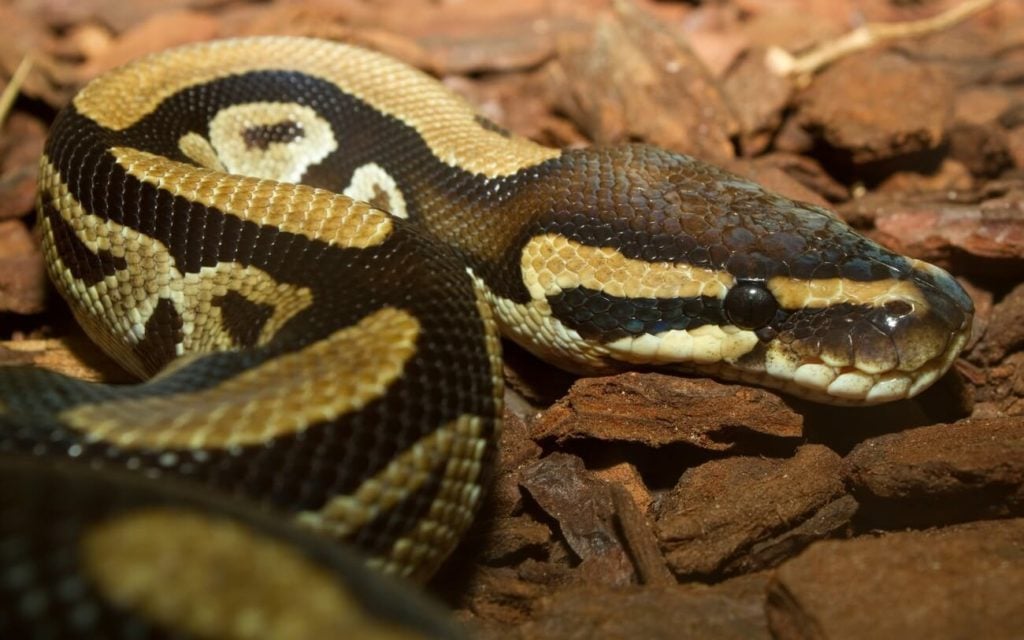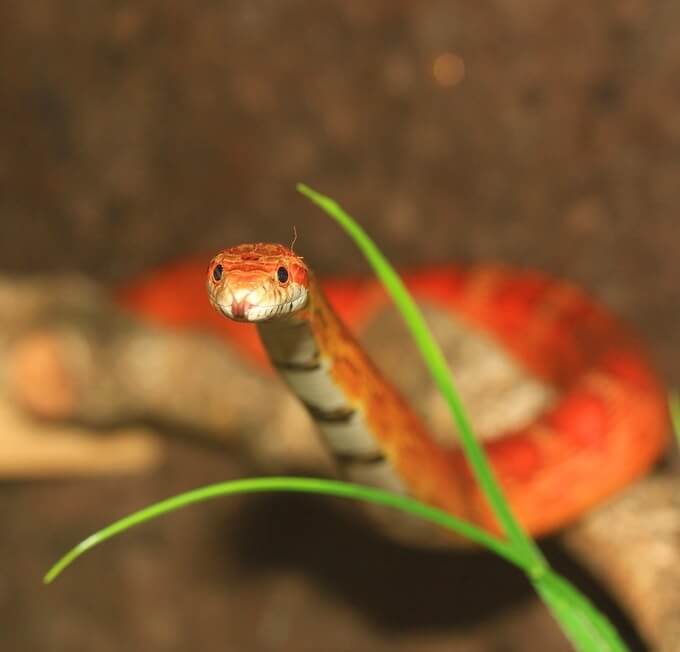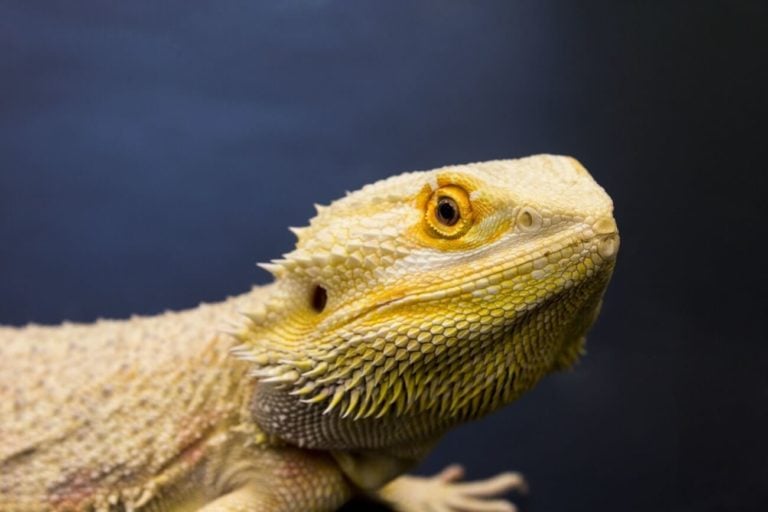Snake mites can be very frustrating for owners and pets alike. These little critters are tricky to identify, and hard to get rid of.
But they don’t have to be such a pain to deal with.
This resource will teach you what snakes mites are, what they look like, how to get rid of them, and how to prevent them from coming back in the future.
Table of Contents
What Are They?
If you own a snake, mites are an issue that you’re bound to deal with at some point. Snake mites are small parasitic bugs that can infest your pet’s enclosure. The bugs latch onto your snake and feed on their blood.
Snake mites aren’t specific to just snakes. These pests can attack any reptile in captivity. Think of these bugs as the fleas of the reptile world. They’re tiny, difficult to see, and just as annoying!
Not only do they feed on your snake’s body, but they also multiply at a rapid pace. It doesn’t take long for a small infestation to become a big one.

To make matters worse, mites are notoriously difficult to get rid of. Colonies can hide in the substrate, burrow into the wood of hide boxes, and live among plants. The insects are also capable of migrating from one animal to another, making infestations incredibly contagious.
You should never ignore snake mite infestations. The issue starts off as a minor one. But if left untreated, mites can quickly overtake your snake’s enclosure and torture your poor snake.
Expert Tip: Serious infestations can also cause internal disease and even death in extreme cases.
Where Do Snake Mites Come From?
Needless to say, it’s best to address snake mites as soon as possible and do your part to prevent future infestations. The key to doing that is understanding how your snake got mites in the first place!
Mites can appear for many different reasons. Here are some of the most common.
Wild-Caught Snakes
Newly captured snakes often have mites. Mites are simply a fact of life in the wild. There’s no natural parasite control, so these insects run rampant.
Thanks to the tiny size of the mites, you might not notice them right away when you buy your new snake. If you don’t quarantine your new pet, you run the risk of spreading the mites to their new habitat. This can cause issues in the future and help the colony grow.
If you want to play it safe, you should quarantine new snakes for at least two months before introducing them to their permanent home.
Cross Contamination
Have you added a new snake to your collection recently? That snake could have brought mites into your home!
Even the most professional snake breeding operations can suffer from mite outbreaks from time to time. The same goes for pet stores. Unless you take the steps to quarantine your new snake, there’s going to be a risk of snake mites appearing.
Never let an unquarantined snake interact with the one you have at home! Remember: mites are very contagious!
Unhygienic Living Conditions
Snake mites are often a sign of poor snake hygiene. Despite their beautiful looks, snakes can actually be quite dirty creatures. If you don’t stay on top of the enclosure conditions, it will turn into a haven for bacteria and pests.
Mites are usually the first parasite to appear. They can invade the environment and quickly cover your snake around the clock. Do your part to keep the enclosure clean so that snake mites don’t become a problem.
Substrate And Enclosure Decor
When not on a snake, you can find mites hiding out in substrate, plants, and even hide boxes. If you’ve recently swapped out the substrate in your snake’s enclosure with a new one, you could have accidentally brought mites into the mix.
Expert Tip: This is especially true with biological substrates filled with organic materials. You don’t have to worry about fresh packaged substrate materials. It’s ones that have been exposed to other animals or insects that you have to worry about.
Human Carriers
The last potential cause of a snake mite infestation is interaction with a human carrier. Snake mites don’t affect humans in the same way that they affect snakes. They’ll crawl on your hands and even get in your clothes.
This means you’re nothing more than a carrier. They won’t bite you. The moment you interact with your snake, those mites will hop off you and migrate to their preferred host.
What Do Snake Mites Look Like?
Individual snake mites can be tough to see because of their small size. But in large droves, they’re easier to spot than you think. You might see several spots of black, red, or gray dots moving around your snake.
You can also see them on your hands after handling a heavily infected snake!
Mites are similar in size to fleas. They have a large, expandable body. This means the more they eat, the larger the mites get.
Snake mites can attack your snake at any spot on the body. There are a couple of ways to look for signs of mites.
The first is by using tape. Start by placing a piece of clear tape on the surface of your snake’s skin. Then, put the tape on a white piece of paper. If there’s a serious infestation, you’ll probably see several black dots.

Seeing mite droppings is very common, too.
This is easier on darker-colored snakes. The droppings look like a fine layer of ash-colored dust. With larger mite issues, those dusty droppings may cover several spots around the snake’s body.
There are a few places that mites tend to gravitate towards as well.
The first is the eyes. The skin is thinner and easier for the mite to bite through around the eyes. In severe cases, the mites can even lodge into the eyeball. With instances like this, the eye might look like it’s surrounded by dirt.
Other common areas for mites to feed include the nostrils and the gular fold. Like the eyes, the nostril has softer skin to get through. Plus, it provides easy access to moist tissue inside.
The gular fold is the small crease on the bottom of the snake’s chin. Gently pull the skin taut and you might see a line of mites sucking your snake dry!
Expert Tip: Mites are also sometimes visible on shed skin. Infestations make it difficult to shed in the first place. But if your snake does manage to remove their old skin, you’ll see tiny black dots on the discarded layer.
Spotting Behavioral Symptoms
Dealing with mites is not fun for your snake! Chances are, they’re dealing with a ton of discomfort. You might even see them doing their best to alleviate the issue on their own!
Snakes can do this by rubbing their skin or soaking. Your snake could rub against decorations in an attempt to “scratch” the mites off. Prolonged soaking is an attempt to drown the bugs!
Once the mites start to feed on your snake, expect changes in behavior. Snakes can become anemic with all that blood loss. This results in extreme lethargy and a loss of appetite.
Not only that, but your snake will be more anxious and irritable. This means you should exercise extra caution when handling them.
How To Treat And Get Rid Of Snake Mites
Getting rid of snake mites isn’t easy. But with the right techniques and products at your disposal, it’s manageable.
In fact, most owners can get rid of the mites on their own without having to go to the vet for help!
The primary goal of treatment is to kill off existing mites that are affecting your snake and those hiding in the enclosure. Simply follow the steps below and you should see great results.
1. Choose A Spray Solution
The first thing you need to do is choose the appropriate spray solution. The solution is going to treat the mites on your snake. You can also use it as a spot killer to take out any mites you see crawling around after you clean the enclosure.
No products found.
You have a few different options here. The first is a natural chemical-free product. Obviously, this is going to be the safest option for you. It’s a good choice if you have a sick snake or one that’s particularly sensitive to chemicals.
Natural formulas don’t contain chemicals. As a result, they’re not always as effective as you would like them to be. They can help keep infestations at bay to some degree.
But for serious mite problems, we recommend using heavier stuff.
Chemical-based formulas that contain Ivermectin or Fipronil work well. Both products attack mites and kill them in minutes. But, they go about the process a bit differently.
Ivermectin is an antiparasitic drug that works by dehydrating snake mites on contact. Some snakes will respond negatively to the drug. Others have no problem with it. It can also dehydrate your snake while it’s working.
Be mindful of any adverse reactions if you use Ivermectin.
Fipronil spray is another common chemical solution. It works by attacking the nervous system of the mites. Fipronil products are all-purpose, so they work to get rid of any other mites that might be affecting your snake.
2. Move Your Snake
Before you start spraying, it’s best to move your snake to a separate enclosure. Use a new plastic tub. This ensures that it’s mite-free.
Move your snake to the tub while you work on their enclosure.
3. Remove Everything From The Enclosure
The first step to get rid of those snake mites is to remove every last thing from the enclosure. This includes the substrate, decor, dishes, and more.
Separate the salvages from the unsalvageable. Products you want to keep might include dishes or plastic decorations. Toss everything else out! It’s best to err on the side of caution with absorbent items.
Mites are notorious for burrowing into cardboard, wood, and anything else they can get into. Seal all those unsalvageable up in a bag and toss them out.
4. Soak Everything In A Bleach Solution
Next, you want to soak the enclosure and all of the decoration items. Use a 3 percent bleach solution with warm water. The water should be higher than 122 degrees Fahrenheit.
Add about three tablespoons of bleach to every quart of water.
Soak the decorations in a separate container. Before you know it, you should start seeing dead snake mites floating on the water.
After soaking, use a sponge to scrub every surface of the enclosure clean. By this point, the snake mites should be dead. But the scrubbing will help to get rid of any leftover mites that might have climbed to safety.
5. Spray Your Snake
Now you can treat your snake! Spray your snake with your chosen product. Always make sure to read the instructions first.
Some products require you to let the solution sit for up to 20 minutes. Follow the directions for the best results.
You should also give the plastic tub you were keeping them as well to kill any mites that fell off your snake.
Expert Tip: Additional applications of the spray may be necessary in the weeks following. Just repeat the process until you no longer see mites in the enclosure or on your snake.
Preventing Them In The Future
The best way to prevent future outbreaks is to limit your snake’s exposure.
If you handle a snake at someone else’s house, make sure to wash your hands before returning home! Even if the snake looks clean, you never know what kinds of parasites or bacteria it’s hiding.
To ensure that snake mites don’t appear in your pet’s enclosure at home, keep it clean! Spot clean messes daily and perform deep cleans about once a month. Deep cleans should involve full sanitization of every surface with a bleach solution.
Finally, you need to take extra precautions when introducing a new snake into your home. All reptiles, whether they’re wild-caught or captive-bred, should ideally be quarantined for two to three months.
Keep them separate from other snakes in your collection and do your part to prevent cross-contamination. During the quarantine, you’ll be able to see if the reptile suffers from mites. If so, treat the issue and wait until there are no more signs of infestation. Only when the snakes are mite-free can you introduce them to your other snakes.
Closing Thoughts
Snake mites are a common source of frustration and discomfort. But as long as you have the right approach, getting rid of them can be a piece of cake.
We hope you found this post useful, and we recommend using it as your guide when dealing with snake mites in the future.
Your snake will be glad you did!


